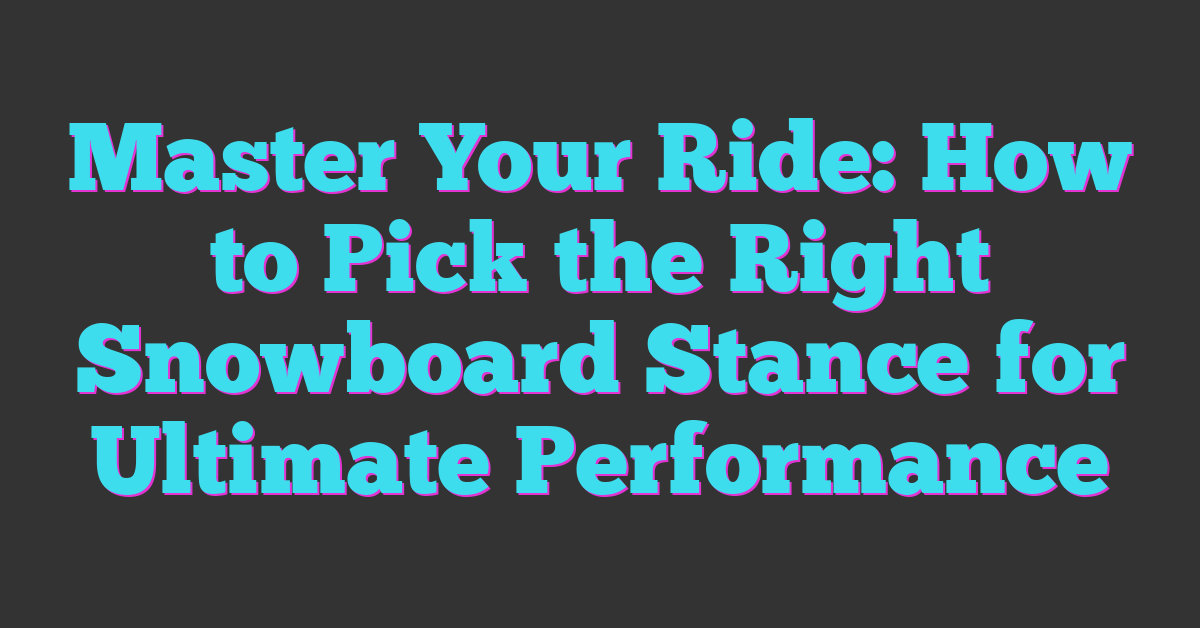Choosing the right snowboard stance can make or break your ride. It’s not just about comfort; the right setup can boost your performance and help you tackle those slopes with confidence. Whether you’re a seasoned pro or just starting out, understanding how to position your feet is essential for maximizing your fun on the mountain.

Understanding Snowboard Stance
Selecting the right snowboard stance plays a vital role in your performance and comfort on the slopes. Knowing how to position your feet helps you carve better and enjoy your ride more.
What Is Snowboard Stance?
Snowboard stance refers to the positioning of your feet on the board. This includes the width, angle, and direction of your bindings. Typically, stances fall into three categories:
- Regular: Left foot forward.
- Goofy: Right foot forward.
- Duck: Both feet pointed outward, ideal for freestyle and switch riding.
Your stance affects how you balance, turn, and respond to obstacles on the mountain. Experimenting with each type helps you discover what feels most natural.
The Importance of Choosing the Right Stance
Choosing the right stance enhances your control, stability, and overall riding experience. An optimal stance leads to better edge control and helps you navigate varied terrain. Consider these factors:
- Personal Comfort: A comfortable stance reduces fatigue.
- Riding Style: Freestyle riders often prefer a wider, duck stance, while alpine riders might favor a narrower, regular stance.
- Skill Level: Beginners benefit from a neutral stance for easier maneuverability.
Invest time in finding your ideal snowboard stance to elevate your skills and enjoy your time outdoors even more.
Types of Snowboard Stances
Understanding snowboard stances can elevate your performance and enhance your overall riding experience. Here’s a closer look at the different types of stances you can choose from.
Regular vs. Goofy
Regular and goofy stances refer to the foot positioning that affects how you ride.
- Regular stance: If you feel more comfortable having your left foot forward, then you ride in a regular stance. This setup offers better balance for most riders during turns and provides a natural feel while going downhill.
- Goofy stance: On the other hand, if you prefer your right foot forward, then you’re in a goofy stance. This choice can enhance agility for riders who naturally balance better this way, allowing for smooth, fluid movements through the snow.
Determining your stance often comes down to your natural preference. You can find out which works better for you by sliding on a board with both stances on flat ground.
Duck Stance
The duck stance involves pointing both feet outward, typically at angles between +15 and -15 degrees.
- Versatility: This stance grants versatility, making it ideal for freestyle riders and those who enjoy tricks. It helps with switch riding and landing jumps effortlessly.
- Stability: Duck stances provide greater stability when navigating various terrains, including halfpipes and snow parks. You’ll find it easier to shift your weight during spins or when hitting rails.
Experimenting with the duck stance can offer a dynamic way to explore your skills on the slopes, allowing for creativity and fun. Consider adjusting your angles to see what feels right for your riding style.
Factors to Consider When Picking Your Stance
Choosing the right snowboard stance involves several vital factors. Keeping these in mind enhances your ride and overall enjoyment on the slopes.
Height and Weight
Height and weight play essential roles in determining your snowboard stance. Taller riders might benefit from a wider stance to maintain balance and stability, while shorter riders may find a narrower stance more comfortable for maneuverability. Similarly, if you weigh more, a wider stance can distribute your weight more evenly across the board, improving control. Always consider your body dimensions when selecting stance width and ensure the measurements suit your riding abilities.
Riding Style
Your riding style greatly influences the stance you choose. Freestyle riders often opt for a duck stance, allowing for better switch riding and tricks. On the other hand, all-mountain riders might prefer a regular or goofy stance for enhanced control while carving or navigating through varied terrain. Different styles require unique approaches, so assess your preferred techniques and select a stance that complements your riding habits.
Foot Size
Foot size directly impacts your stance and binding positioning. Larger foot sizes often necessitate a wider stance to avoid toe drag during turns, which can slow you down or lead to falls. If your feet are on the smaller side, a narrower stance may enhance your responsiveness and agility. Always ensure that your bindings are positioned correctly to accommodate your foot size, maximizing your comfort and performance on the board.
How to Test Your Stance
Testing your snowboard stance is key to finding a setup that feels comfortable and enhances your ride. You can evaluate both on the snow and off the snow, ensuring you’re dialed in before hitting those slopes.
On the Snow
Start on flat terrain, where you can safely practice different stances. Position your board with your bindings facing downhill. Strap in one foot and keep the other foot free for testing. Push yourself slightly with your free foot to feel the board’s response.
- Try Regular: With your left foot forward, lean into it and make a few easy turns. Notice how you feel balancing and controlling the board.
- Try Goofy: Switch to a goofy stance, leading with your right foot. Again, make gentle turns and feel how the board reacts.
- Experiment with Duck: Finally, test the duck stance by adjusting your bindings so both feet point outwards. This setup offers a versatile feel for tricks and switch riding.
Take note of your comfort level and balance across these three stances. The more you test, the clearer your preference becomes.
Off the Snow
Evaluating your stance off the snow can provide additional insights. Start by standing with your feet shoulder-width apart.
- Jump Test: Jump a few times, paying attention to how you land. A comfortable stance will feel balanced and stable, without awkward adjustments.
- Foot Placement: Pay attention to your foot positioning naturally. Most people have a dominant foot that tends to lead. If you feel stronger boarding with one foot, that could guide your stance choice.
- Get Feedback: Ask a friend to observe your stance while you’re standing. Sometimes, outside perspectives help you identify what feels right versus what looks right.
By combining both on-snow and off-snow tests, you’ll identify the stance that offers you the best performance and comfort, readying you for epic rides ahead.
Tips for Adjusting Your Stance
Adjusting your snowboard stance can significantly enhance your riding experience. Finding the optimal setup won’t only improve your performance but also increase your comfort on the slopes.
Recommended Angles
Start by considering the angles of your bindings. Most riders find success with angles between -15 to +15 degrees, which allows a bit of natural foot positioning. For a more balanced feel, set your front foot at about +15 degrees and your back foot at -6 degrees. This setup offers a good compromise between switch riding and maintaining stability on regular runs. If you favor freestyle tricks, experiment with more duck angles, like -15 degrees and +15 degrees. These will facilitate smoother transitions between regular and switch riding. Adjust your angles gradually, and take the time to notice how each change affects your balance and control.
Finding Comfort
Comfort plays a crucial role in your snowboarding stance. A stance that feels off can lead to fatigue and less enjoyable days on the mountain. Pay attention to your knees and hips; they should align comfortably while riding. Stand with your feet shoulder-width apart on flat ground, then strap into your board to find the most natural position for your feet. If your feet feel cramped or stretched, tweak the width of your stance. It’s also wise to consider your riding style; freestyle enthusiasts may favor a slightly wider stance to allow for better landings, while alpine riders often stick with a narrower setup for increased edge control. Ultimately, your comfort and riding preference guide your setup, so don’t hesitate to make adjustments until you find what feels just right.
Conclusion
Finding the right snowboard stance can truly transform your riding experience. It’s all about comfort and control so don’t hesitate to experiment with different setups. Whether you lean towards regular goofy or duck stances remember that your preferences will shape your performance on the slopes.
Take your time to test out various angles and widths. Listen to your body and pay attention to what feels good. With a little practice you’ll discover the stance that enhances your balance and agility. Enjoy the ride and embrace the snow with confidence!
















